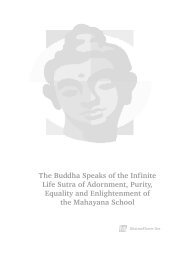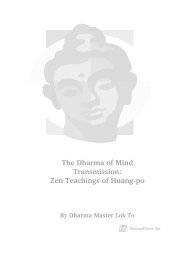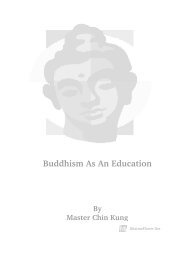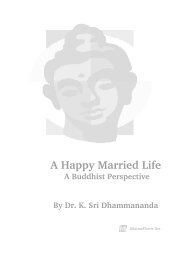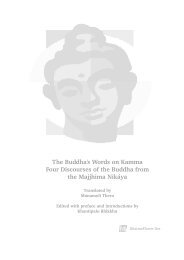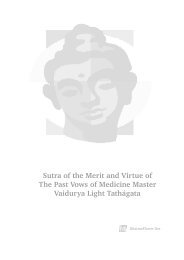Vipassana Meditation : Lectures On Insight Meditation by Venerable
Vipassana Meditation : Lectures On Insight Meditation by Venerable
Vipassana Meditation : Lectures On Insight Meditation by Venerable
You also want an ePaper? Increase the reach of your titles
YUMPU automatically turns print PDFs into web optimized ePapers that Google loves.
A Samatha meditator has to make some device or kasina as the object ofmeditation. For instance, to make a color kasina, he has to make a red circleon the wall about two feet from the floor in accordance with theVisuddhimagga commentary. He must make the red circle about the size of aplate and the color must be of pure red, even and smooth. When the devicehas been made, then he has to sit on the floor about two feet from the wall,look at the red circle and concentrate on it. Should the mind wander, he mustnot follow the mind but he must bring it to the object of meditation, i.e., thered circle. He must focus the mind on the red circle and observe it as 'red, red,red'. This is the way of Samatha meditation in brief.As for <strong>Vipassana</strong> meditation, the purpose is to attain the cessation ofsuffering through rightly understanding mental and physical processes in theirtrue nature. For this, we need some degree of concentration. Thisconcentration can be attained through constant and uninterrupted mindfulnessof the mind-body process. Thus, we have a variety of objects of meditation:happiness is an object of meditation and so is anger, sorrow, painful sensation,stiffness, numbness and so on. Any mental or physical process can be theobject of meditation.The purpose and the results of Samatha and <strong>Vipassana</strong> meditation aredifferent, as are the methods.We should go back to what I explained earlier. When we walk, we observethe movement of the foot - the lifting, pushing and dropping. At the beginningof the practice, our mind is not well concentrated on the foot. When the mindwanders, we have to follow it and observe it as it is until that wandering mindhas disappear. <strong>On</strong>ly after it has disappeared, do we note the movement of thefoot as usual. When the mind becomes well concentrated on the movement ofthe foot, what we note is the movement of lifting, pushing and dropping andwe must not be aware of the form of the foot or the form of the body duringwalking. When the foot is lifted, the mind notes it as lifting, when the foot ispushed forward, the mind notes it as pushing, when the foot is dropped, themind notes it as dropping. When we come to realize them as natural processesof movement, we also come to realize the mind that notes them. The liftingmovement is one process and the mind that notes it is another process. Thepushing movement is one process and the mind that notes it is anotherprocess. In this way, we thoroughly realize the two processes of mentalphenomena and physical phenomena. We rightly understand this dual processas just natural processes of mental and physical phenomena. We do not takethem to be a person, a 'being' and 'I' or 'you'. Then there will not arise any falseconcept of personality, individuality, soul or self. When this false concept hasbeen destroyed, there will not arise any attachment or desire, which is thecause of suffering (dukkha). So, because attachment does not arise, there willnot arise any dukkha, which is actually the results of the attachment. We attainthe sensation of suffering at he moment of experiencing the process of themovement the lifting, pushing and dropping movement - as just a naturalprocess.8



